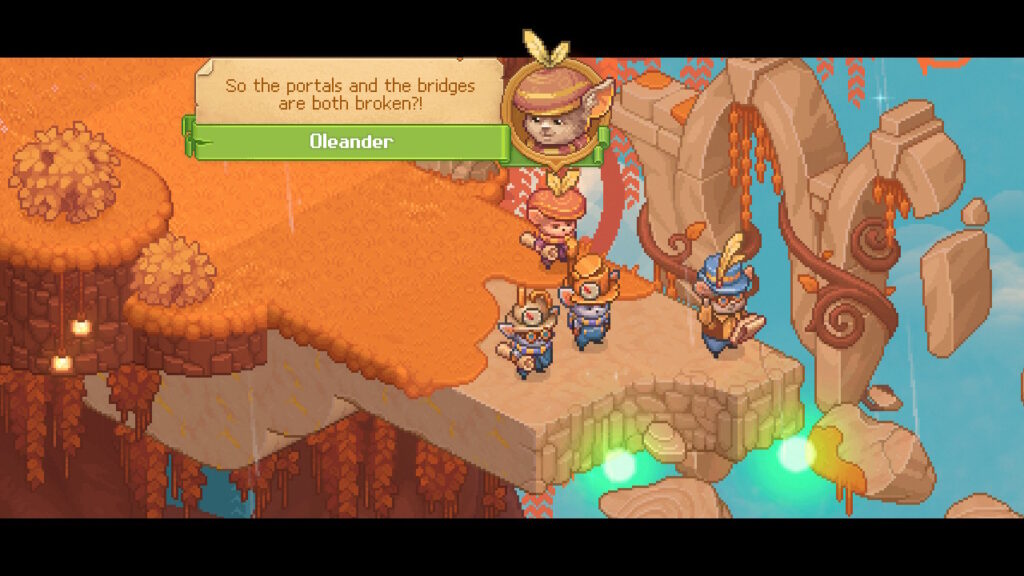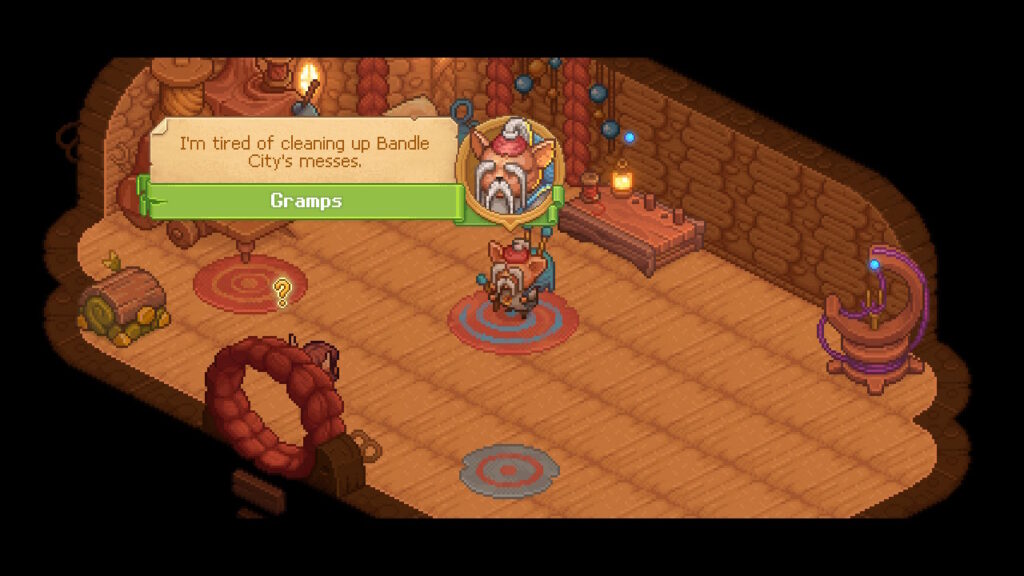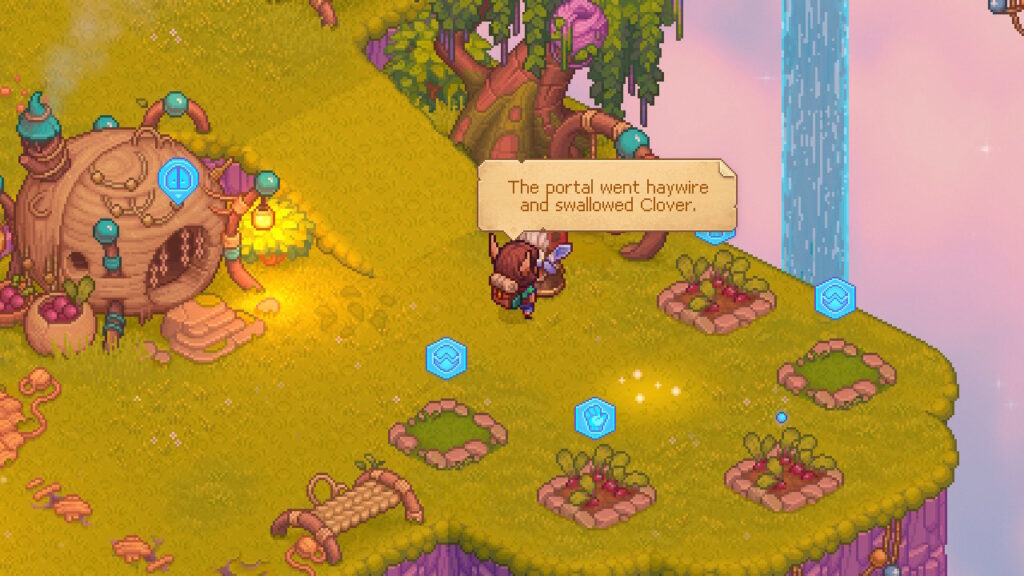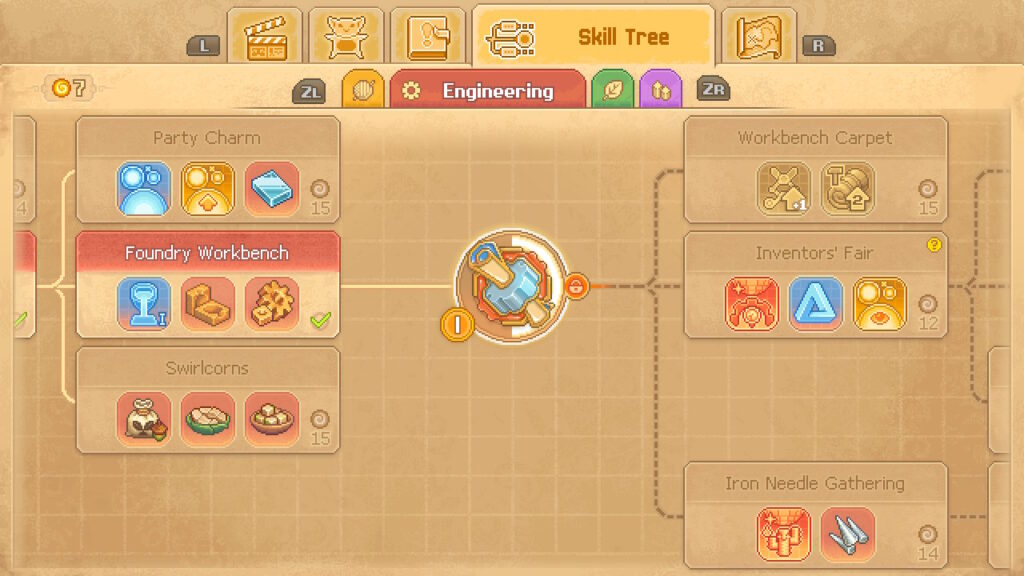Welcome to my Bandle Tale review. We were not given a review code for this title.
Bandle Tale: A League of Legends Story is a cozy side story from the League of Legends universe. I am not a LoL player so forgive my weak knowledge of the lore, but I had to pick up Bandle Tale once I saw how cute and crafty it was. You play as a young yordel tasked with reuniting their home islands after an ill-fated party disaster eliminates the magical portals between them.
For those not in the know (like me), a yordle in League of Legends is a fictional race of small, humanoid creatures within the game’s lore. They are characterized by their diminutive size, furry appearance, and mischievous nature. Some popular Yordle champions include Teemo, Tristana, and Lulu.
- Bandle Tale on Steam
- Bandle Tale on Nintendo Switch
- Bandle Tale on GoG
- Bandle Tale on Epic Game Store
This review may contain minor spoilers for gameplay and story beats, though I always try not to reveal any major plot twists or surprises.

First Impressions
I’ll admit, the marketing materials and ads for this game really roped me in. A game that wasn’t even on my radar became one I was exceedingly excited to try. The characters are cute, the graphics are beautifully vibrant pixel art, and the story premise is whimsical and silly. An explosive portal at a yordle gathering sends the islands and their inhabitants into chaos! A simple yet intriguing concept.
Unfortunately, I was let down almost from the start. The movement and controls feel clunky, the tasks are uninteresting, the landscape is annoying to traverse, and the quest instructions are confusing and obtuse. Does this mean anything to you:
Craft Portal Yarn on Charge Workbench. Needs Portal Knitting.
Because I am an hour or so into the game, that is my current quest, and it doesn’t mean anything to me, either.
Here’s hoping things look up.

Characters & Story
Okay, bear with me here: You are an apprentice yordle who recently graduated from 101 years of training, you love to knit, and a party disaster caused a portal to erupt and swallow up your friend Clover. In a quest to find her, you begin the arduous process of gathering the resources needed to mend the portal for the ultimate rescue mission. To mend the portal you need…to host Food Stands to earn currency and improve the mood of islanders and throw festivals in order to collect Unity Yarn from the attendees. If residents are having a blast, they will excrete more Unity Yarn, I guess. So it’s up to you to host the best parties ever.
The premise is wacky and a bit hard to follow. But the characters are genuinely quirky and lovable and the game does a good job of dropping breadcrumbs for larger story twists incrementally. Like, why did your grandpa separate your home from the rest of the floating islands? What is he hiding? And how did the portal go so wrong in the first place?
You will mostly spend time alone but with a portable house in a backpack you can easily traipse about and visit whom you please. (I can’t help but feel like I am missing some critical yordel lore here…) “Colorful cast of characters” is a cliche I fall back on far too often but it both literally and figuratively applies here. Besides your grandpa, you will meet rival university professors and their students; enterprising shop owners; quirky inventors and scientists; and a famous party host/DJ.
The dialogue is light-hearted and endearing, but the dry humor doesn’t always land. There are a lot of jokes you will see from a mile away, stuff you’ve heard before on every after school sitcom. “He’s right behind me, isn’t he?” type comedy tropes. There’s nothing wrong with leaning on the tried and true (colorful cast of characters, anyone?) but you always run the risk of wasting the audience’s time if you don’t have anything authentic or valuable to talk about. A lot of the conversations felt like that: flat banter to slow you down and extend your playtime. I rarely felt like I cared what anyone had to say.

Gameplay Loop
The gameplay loop for Bandle Tale is…convoluted, at best. There is a basic resource collection and crafting system…only, certain resources can only be collected after unlocking their associated skill tree power. For example, you can’t collect gems and rocks until you unlock the skill “Mineral Gathering.” There isn’t a great mechanical or story-based reason for this, either; your character is just clearly incompetent after their 100+ year apprenticeship.
I guess I should have started with the skill tree and the Emotion Orbs. But that’s part of the problem with the game: it throws too many needless layers onto the simplest task. Maybe it’s supposed to be a metaphor for disability or something, as the MC has a permanently injured leg. I digress—Emotion Orbs turn into skill points when you sleep at night. In order to fill the orbs and collect said booty, you need to perform actions that make the character happy. Luckily, everything seems to do so, from repairing, building, crafting, eating, gathering, completing quests, and exploring. Being too repetitive with your actions will stunt your growth though, so you need to mix it up daily.
There is no standard day/night cycle. Time passes and you sleep when you are ready to cash in your orbs for skill points. At the beginning, you have a maximum of 3 Emotion Orbs daily but you will unlock more as you go. Once you have enough skill points, you can start filling out your skill tree in the areas of knitting, engineering, magic, and nature. Don’t spend them all in one place, though, as the quest progression is very clear about what you need and when.

Despite the variety of tasks, it can be surprisingly hard to fill those darn orbs. I spent a ton of time running around looking for something—anything—to do. But resource gathering areas were scarce and tons of environmental interaction was locked behind the skill tree nodes. I ended up crafting a bunch of junk I didn’t need just for a hit of the stuff. It’s very clear that the game wants you to go to point A and then B and then C, in that order—and they place a ton of blockades in your way to ensure you don’t stray.
But even mindless crafting wasn’t easy—thanks in part to “Auras.” Auras are glowing, patterned ground tiles that are required to craft certain things. However, to find the right Aura for your recipe you will have to traverse portals, tubes, tunnels, bridges, secret doors, and so on. It is rarely easy to find what you need and the best method of travel—using portals—requires an Aura-touched item to make in the first place. The running around I did just to craft a seed here or a stall there was insane.
Speaking of insane, there are so many degrees of separation between your daily tasks and your ultimate goal that it gets very convoluted very quickly. Ultimately, you need Portal Yarn to fix the portals and rescue Clover. In order to get Portal Yarn, you must first find Unity Yarn. Unity Yarn can be collected from townsfolk who attend festivals—designed by you!—if they are having a smashing time. You can increase their mood by activating different props, from drink tables to dance floors and more.
The way you “activate” these amenities is by…clicking on them repeatedly. Yeah. The whole festival sequence will feel kind of like an auto-clicker mobile game. Which isn’t…great. By the way, festivals can only happen if you have the right “vibe” in the neighborhood and a certain number of guests. You can improve the vibe by helping people out around town. Once everyone is satisfied, you can plan your party.
The festival planning is a sequence of guess-and-check decisions until you start figuring out what people like (and obtaining the decor to satisfy them). You can choose music genre, lights aesthetic, and equipment for food, dance, and other assorted fun. Wait! Did I tell you about carpets yet? Those are critical to hosting Food Stalls and Festivals. So let’s back up a bit.

Once you secure your backpack/portable home, you can build and unfurl event-appropriate carpets. This is required to place items outside and get the party started. A gold glowing sphere will help you unfurl them and, er, re-furl them at will. All of your placed items will stay where they are on the carpet, even after being withdrawn and replaced.
Carpets, among other contraptions, can be built by foraging the right raw materials, crafting the associated resources, and entering the build menu at the front of your house. Because your home is portable, all these enrichments come with you whenever you go. This is handy because the landscape is winding, narrow, cluttered, and riddled with dead ends—and not so fun to explore because of that. So not needing to hustle back to a homebase every night is a relief.
Oh yeah: I briefly mentioned Food Stalls. That’s how you earn stars (currency), along with a small marketplace you unlock later. Each has their own associated carpet that you can unveil to activate the different activities. To succeed at earning that bling, you will be subjected to time management point-and-click minigames. They are, to get technical, very meh. Blockades in the environment, like rocks or buildings, can actually limit which carpet fits where. So there will be areas where you can host a festival but not a Food Stall, for example. It’s all a bit…exhausting.
Getting confused yet? Yeah. The game layers complexity on thick, and not always in a good way. Everything seems 3X as complicated as it needs to be. It honestly feels like they were making two or three separate games and decided to blend them into one at the last minute.
This game gets in its own way—and in the player’s way—a lot. You aren’t particularly free to roam, cutscenes are disruptively frequent, and even basic mechanics like picking up rocks is locked behind some sort of game progression mechanic. I found myself doing a lot of aimless walking. Talk to this person, then that; visit this area, solve a puzzle; look at a statue or a waterfall; et cetera, et cetera. Nothing felt fun or substantial. The majority of my time spent “playing” didn’t feel like a game at all. It felt like running a really long and tedious errand.

Technical Issues
I did not encounter any technical issues while playing Bandle Tale!
Summary
Who reads reviews anymore? Here is the TLDR:
Pros
- Cute and whimsical setting
- Colorful cast of characters
- Blend of puzzles and crafting
Cons
- Difficult to get from place to place
- Frustrating Aura system gets in the way of crafting feeling good
- Rigidly linear in what you need to do to progress

Conclusion
Bandle Tale is the definition of “a whimsical world” and “colorful cast of characters”—two of my favorite game review phrases. It blends bright rainforest colors and charming steampunk clutter. There is a rich story of self discovery and empowerment buried somewhere deep within all the busywork.
However, the strict linear progression makes solving puzzles, unlocking skills, and expanding crafting capabilities muddy and tedious. The game gets in its own way, turning every task into a slog of traversing cluttered and winding landscapes and meddling with a chaotic crafting and level up system that just isn’t fun. I really wanted to like this game, but it fell far short of my expectations, particularly knowing the firepower behind the League of Legends brand.
I would recommend buying Bandle Tale on a steep discount if you want to try it out—say, 50% off or more. Keep it on your Steam wishlist or follow @cozygamereview on socials for game deal alerts.
Who Bandle Tale is for…
- Fans of a cozy League of Legends side story concept
- Those who like slow, methodical progression
- People who like “idle clicker”-type mechanics
Who Bandle Tale is not for…
- Those who prefer a sandbox experience
- Players who can’t survive without a dash/sprint button
- Anyone who has memory or focus issues
Stay cozy, gamers!
If you liked Bandle Tale, you might also like Minako’s Night Market.
